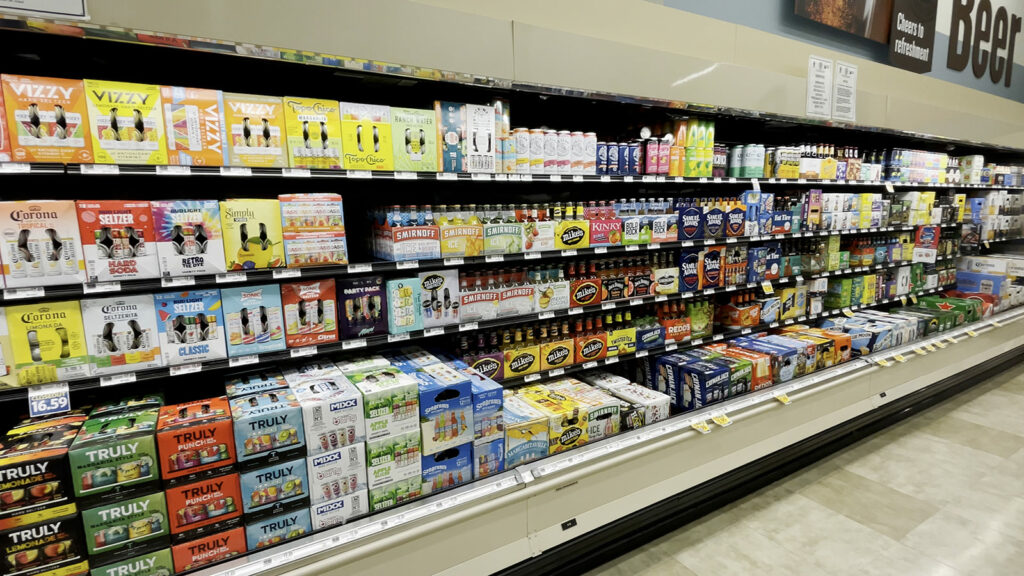The State of Variety Case Packing

More and more customers want variety cases because it allows them to test different flavors of products without having to buy separate single flavor cases. © billtster – stock.adobe.com
Thinking Outside the Box
By: Krupa Ravichandraan, Bosch Rexroth Solutions Architect, Consumer Packaged Goods
For the last 50 plus years, case packing machines have evolved from use of mechanical components like cams, pneumatic actuators, pumps and springs to use of mechatronic solutions including servomotors, electric linear actuators, high speed cameras, and magnetic systems. This evolution has improved efficiency of machines, added flexibility, increased speed, and reduced size of the machines. Many OEMs have also started adopting use of smaller robots to do case packing instead of the traditional methods.
There are various types of case packers — top loader, side loader and bottom loader. In most of these packers, there is a need for product priming; this is especially true for products like polyethylene terephthalate (PET) bottles, glass bottles and aluminum cans. The products must be ‘laned’ to get the correct pack size and product pattern inside the case; so there is a need for a laner, that is either standalone or integrated with the packer. This process is followed by synchronized movements to get the products into erected cases without any damage to products or cases.
Conventional machines were designed with the mechanical and electrical products that were available at that time, with minor incremental innovation time to time. Use of linear motor driven high speed conveyance systems has allowed original equipment manufacturers (OEMs) to utilize that flexibility to increase machine speed slightly. However, these technologies are still used in the conventional design frame of mind.

Bosch Rexroth provides automation solutions to CPG manufacturers in an effort to meet the shifting needs of the industry. Image contributed by Bosch Rexroth.
Industry challenges
Consumer packaged goods manufacturers are facing ever increasing challenges. The pandemic-fueled shortage of skilled labor and increasing cost of labor has put pressure to continuously revamp manufacturing capacity, both machinery and people skills. Customer driven demand for wide variety of product flavors, sizes and marketing needs has led to need for new packaging lines with modern technologies.
The associated cost involved in upgrading equipment, retraining people, and the time needed to attain optimal production output consistently is a challenge. There is pressure on manufacturer profit margins due to intense competition, market forces, changing customer preferences, and governmental regulations among various other factors.
Maximizing production line efficiency, throughput and reducing downtime is highly crucial. When fragile products like glass bottles are transported on a conveyor, there are high chances for fallen products due to traffic which could lead to damage and line stop. Even though cost associated with damage is negligible, downtime and resource diversion to fix the issue over long periods of time takes away a chunk of the manufacturer’s profit margin.
Evolution of technology
Technology has evolved rapidly over the last two decades: AI and machine learning capabilities seem to be reaching a tipping point for further growth possibilities, and the global call for sustainability and carbon footprint reduction is ever increasing.
Nontraditional very high-speed flow systems, seven axis cobots, and 6D contactless planar motion have provided OEMs with endless possibilities to solve customer problems. Similarly, the appetites of customers have evolved over the years. There is need for customized products, new product marketing strategies driven by uniqueness and individuality requirements from customers. Flexibility, reliability, speed, sustainable packaging and machine compactness are the need of the day.
Needed action
All these factors must serve as a catalyst to go back to the drawing board and approach case packaging and machinery design with a new set of eyes to both OEMs and end users. This requires understanding the various technologies and solutions that are available in the market today, what will become available in the future, evolving market trends and consumer preferences, and how to effectively use those solutions to help consumer packaged goods (CPG) manufacturers.
There is also the challenge of stiff competition, aggressive innovation which makes packaging machinery OEMs continuously evaluate how to stay competitive and innovative and always remain a few steps ahead of their competition. Recently end users have started to invest in research and development of their own automation concept solutions to meet their needs in-house in the hope of tailored solutions. There is a need for mindset shift to thrive and succeed in this new digital age post-pandemic.
Variety packing methods

High speed flexible and modular product flow systems such as ctrlX HS and ctrlX 6D help to modernize the variety case packaging machinery to make it more compact, increase speed, flexibility and modularity. Image contributed by Bosch Rexroth.
One particular area that needs more attention is variety case packing. Recently, more and more customers want variety cases because it allows them to test different flavors of products without having to buy separate single flavor cases.
Variety packs are also a way for manufacturers to test their products in the market to evaluate customer feedback without going into large scale production and investment in million-dollar production lines. Consider consumers, especially large families or group of friends where each individual prefers a different flavor. A Jim might want an orange flavored soda but Mary might want cherry flavor. Variety cases are a great way to satiate different needs without spending a lot of money on large single flavor cases.
Manufacturers noticed this trend and are revamping and adding capacity to their production facilities to cater to this emerging demand. This is particularly true in the case of beverage manufacturers.
Traditionally, variety case packing of bottles, cans and other similar products involves packing single SKU cases with a single flavor in a production run, repeating that process for various flavors, and storing the pallets of single SKU cases in a warehouse. When it is time to make variety cases, these single SKU cases will be brought back from warehouses. If we want to build a variety case with four different flavors, then the cases of the four different flavors would be opened, and products would be placed on separate conveyors. The single flavor bottles or cans would then be unloaded onto dedicated conveyors in-mass, single filed, laned and packed in variety cases.
With this approach, manufacturers are constrained with the traditional conveyors, laners, sorters and excessive changeover parts and associated changeover times. In addition, adding more flavors and different lines will require new equipment and more floor space. Upgrading existing equipment can actually lead to additional costs for manufacturers.
In addition to that, products falling and corresponding breakage might cause a traffic jam in the production line, leading to line efficiency issues. Unplanned, random and frequent micro-stops due to product breakage or fallen products put pressure on the operations team to be reactive instead of focusing on continuous improvements on the plant to get maximum profit margins for their organization. There is hope with the use of emerging technologies and solutions to approach this problem with different design thinking.
What’s next?
High speed flexible and modular product flow systems such as ctrlX HS and ctrlX 6D help to modernize the variety case packaging machinery to make it more compact, increase speed, flexibility and modularity. These new technologies allow OEMs and end user manufacturers to reduce unplanned machine downtime, reduce the number of change parts and changeover times. For example, a traffic jam in the line due to a fallen product or a sudden failure of a part or two in a non-modular case packing line could result in multiple micro-stops and reduce the overall line efficiency; this can be highly optimized by overhauling the machine design and process with these new reliable technologies.
In addition to that, end-users seek more control over how they can use their existing and future floor space optimally. Upcoming technologies and solutions will empower the end user to achieve that level of modularity. Because such machines will be simple and have less complicated parts, minimal skills and training will be required to operate and maintain these machines. More and more use of autonomous mobile robots, advanced factory floor navigation software and humanoids will require machines that will have a simple changeover system and a smaller number of change parts. Flexibility, an open-source controls platform like ctrlX and simple designs are here to thrive; those who embrace the change will have a higher chance of catching the upcoming waves of new growth and possibilities.
About the Author
Krupa Ravichandraan is a Solutions Architect with the Consumer Packaged Goods team at Bosch Rexroth. Learn more at www.boschrexroth.com.







